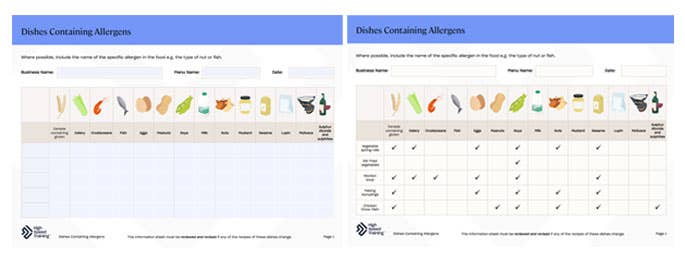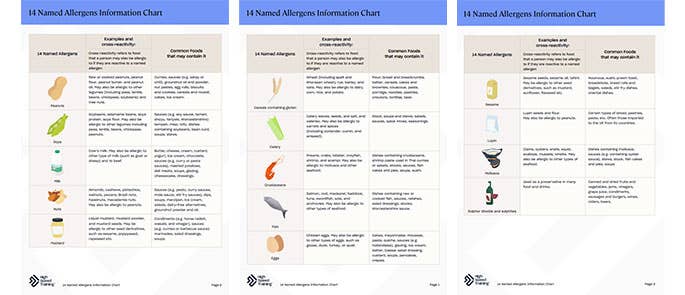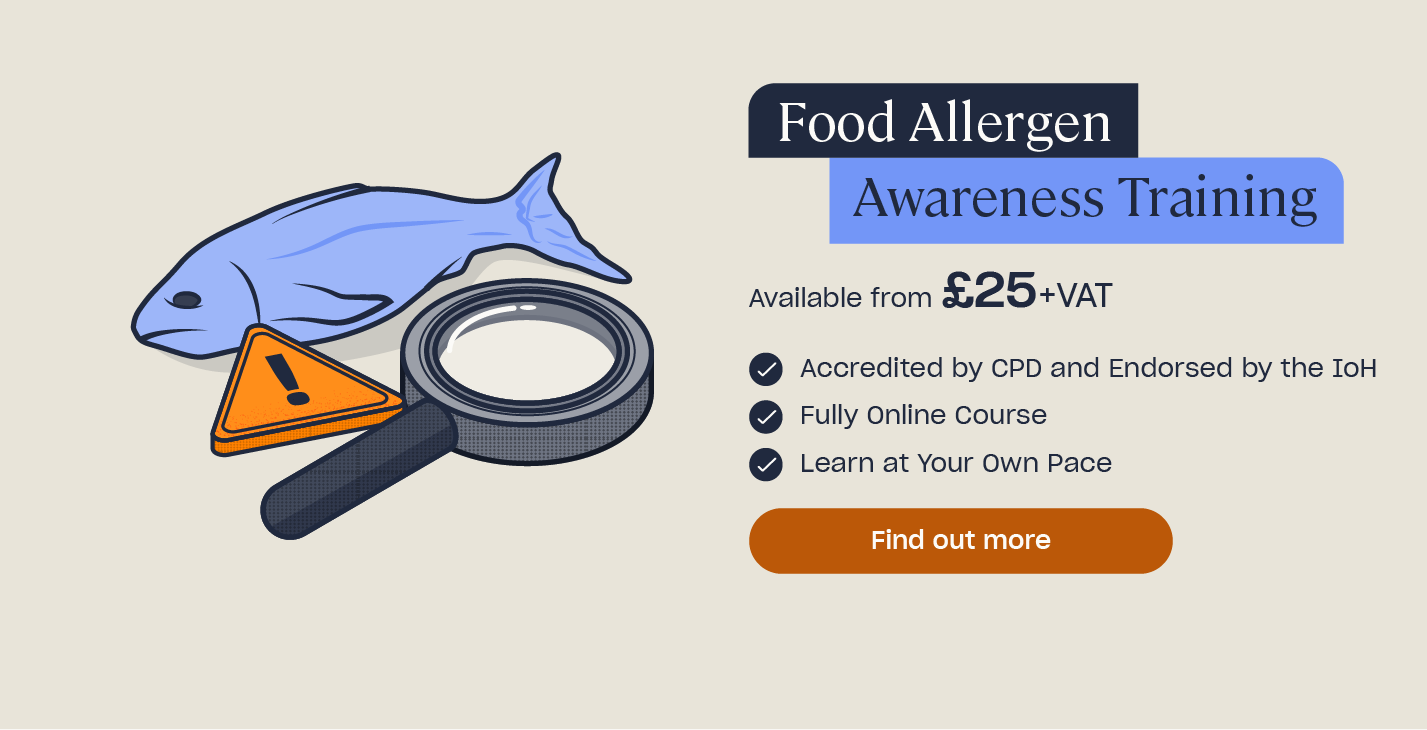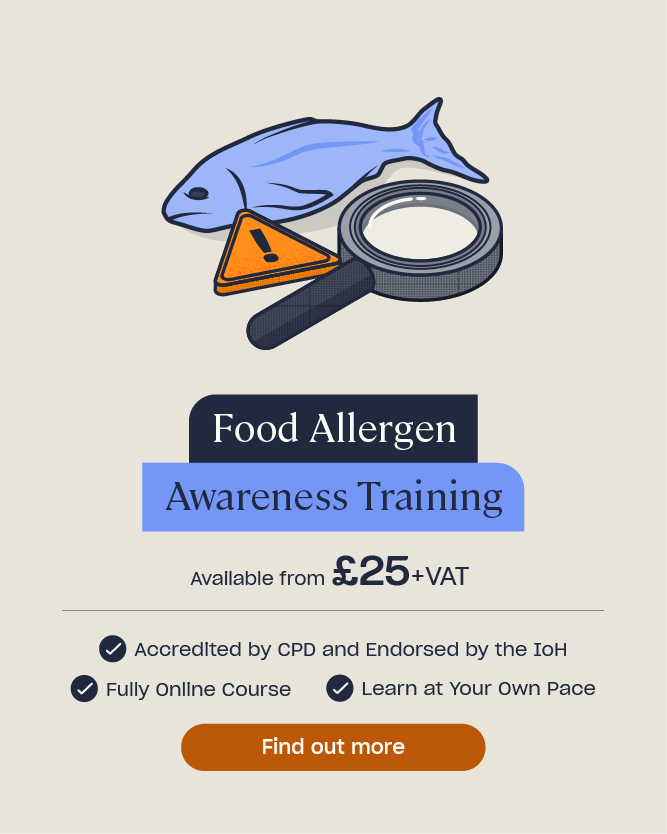Food Allergy Chart Template for Hospitality
If your food business sells anything that contains allergens, then it’s crucial for you to track this information accurately. Allowing someone to unknowingly consume food they’re allergic to is extremely dangerous and a serious food safety offence.
That’s why you should have a food allergy chart prepared. This enables you to see at a glance which dishes on your menu contain which allergens. With this in mind, we’ve created a free downloadable food allergy chart template that you can use in your business.

With an estimated 2 million people in the UK with a diagnosed food allergy, you can’t afford to be careless when it comes to allergens. Plus, allergen regulations have become even stricter following Natasha’s Law coming into force in October 2021.
Your food business will be a cut above the rest if you can clearly and confidently inform customers about the allergens you use. You’ll be able to protect them from harm and comply with food safety law.
Need a Course?
Our Food Allergen Awareness Training will teach you how to comply with the UK’s allergen laws, so you understand which foods commonly cause allergic reactions, how these should be labelled on food products under the EU Food Information for Consumers (FIC) Regulation, and how to ensure customers are provided with accurate information about the food they are purchasing.
What is a Food Allergy Chart?
A food allergy chart is a template that you’ll use to record which foods on your menu contain one or more of the 14 named allergens. It can be tricky to remember all of them, so having a chart is extremely useful. It allows staff to see at a glance which dishes contain allergens and advise customers with allergies about what to order.
Using an allergen list template isn’t required by law. However, you are legally required to be able to fully and accurately inform customers about allergens in the food you sell. Having all this information in one place, so staff can communicate it to customers, is an effective way to do so.
In your food allergy chart, the top row will contain all 14 of the named allergens, while the first column will contain a list of all your menu items that contain any of these allergens. You will then tick the boxes that correspond with the allergens in those dishes.

Where relevant you’ll also list the specific allergens in the foods, such as the type of nut or fish. This allows customers to use their discretion on whether or not to order, as they may only have an allergy to a certain type and not others. For example, someone with an allergy to hazelnuts may not be allergic to other types of nuts.
Where Should My Business Display its Food Allergy Chart?
It’s vital for allergen information to be readily available for customers. This doesn’t necessarily mean pinning your food allergy charts on the wall, but it is important for both staff and customers to have access to this information when needed.
Therefore, your food business should:
- Include a clear statement in the menu saying that customers can request advice on allergens from a member of staff. This will prompt staff to consult the chart and help customers choose a safe option.
- Keep all food allergy charts in a location where staff can easily access them. Ensure everyone knows where the charts are and that they don’t put them anywhere else. Staff need quick access if asked about allergens. Otherwise, they may have to try and remember and may do so inaccurately.
- Consider creating multiple copies for each member of staff, so they have immediate access throughout the day. This reflects well on your business – customers will be impressed by your commitment to allergen safety.
- Consider inserting your food allergens charts in the menu. Giving customers this level of autonomy can make them feel incredibly reassured and confident in your safety procedures.
- Consider also having your food allergy charts available online. Customers will most likely check your menu beforehand. Seeing that you have detailed allergen information could be hugely reassuring and a selling point for them.
Even if staff feel confident in their knowledge of allergens, they should not recite them off the top of their head. They should ideally check the chart every time they’re asked for advice, as they could easily misremember. The recipe may have even changed and the chart may have been updated since they last memorised it.

This is also why it’s crucial for someone to frequently review allergen charts. If recipes change or you use a new supplier, the allergens information may no longer be accurate. All copies must be updated when changes occur.
Don’t forget about online versions. Customers may come and order food based on outdated information that they read online beforehand, which could have severe consequences.
Free Food Allergy Chart Template and Example
Our free food allergy chart template allows you to make a clear record of which foods you sell that contain allergens. It’s simple and easy to use, and acts as an excellent reminder for staff on which foods may or may not be safe for certain customers.
We have also created a filled-in example, so you can get an idea of how to use the chart.

We also provide a downloadable allergens information sheet. This lists all 14 named allergens, common examples, cross-reactivity (foods that a person may also be allergic to if they are to a named allergen), and examples of ingredients and dishes that you may find named allergens in.
This will help you enhance staff’s understanding of allergens, which is vital for those working in a food business. It’s especially important if they don’t have much previous knowledge. Without a strong awareness, they could put customers at risk and the business will be held responsible for inadequate training.

Having an awareness of which allergens are in the foods you sell is crucial. One of the most reliable ways to track this information is with a food allergy chart, so do use them wherever possible in your workplace. Remember to frequently review your charts so that altered recipes or new suppliers don’t create a risk for those with allergies.
What to Read Next:
- Free 14 Allergens Poster
- What Does Natasha’s Law Mean for My Business?
- Food Allergen Risk Assessment & Checklist: Free Templates
- Online Allergen Awareness Training Course











